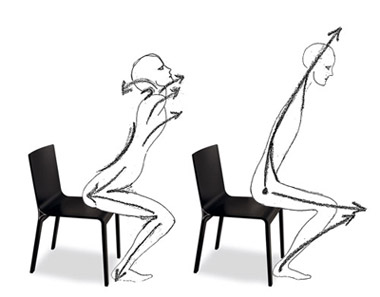What Happens During an Alexander Technique Lesson or Class
- Details
- Written by AndEl

(Much of the following has been taken from Chapter 4, "The Alexander Lesson" in Fitness Without Stress by Robert Rickover.)
When I speak to new pupils on the telephone before their first lesson, I find they often have questions about what will go on during the lesson and about the teaching process itself.
What Not to Expect
For a start, you don't remove your clothes. Nor is any kind of special clothing required - though as table work often forms part of the lesson, women pupils usually feel more comfortable wearing slacks, or jeans, rather than a skirt.
Alexander lessons are not painful. There is nothing physically aggressive about the work. On the contrary, it is a process of allowing the pupil to release tension and the harmful habits that were responsible for it - at the pace that suits him or her, individually.
What Does the Teacher Do?
During the lesson your teacher will be observing your posture and movement patterns. She will also supplement the visual information in a very important way by using her hands, gently placing them on your neck, shoulders, back and so on. The teacher is using her hands in order to get more refined information about your patterns of breathing and moving.
To help her with this, she will probably ask you to perform some simple movements - perhaps walking, or standing up or sitting down in a chair - while her hands are kept in easy contact with your body.
At the same time that the teacher's hands are gathering information, they will also be conveying information to you. The teacher's hands will gently guide your body to encourage a release of restrictive muscular tension.
Naturally, teachers vary somewhat in their approaches to teaching. Just like any other group of professionals, there are variations due to differences in personality and style of training. Some teachers may talk and explain more at first; others prefer to spend most of the time during the first lessons simply helping you to get a new experience of ease and flexibility. Similarly, some teachers emphasize a few, fairly basic movements, allowing the effect to carry over into all your activities, while others prefer to work with you in a wide variety of applications.
How Long Are Lessons - And How Many Will I Need?
A lesson usually lasts between thirty and forty-five minutes. It will probably take a few lessons for you and your teacher to get an idea of how quickly you will make progress. As with learning other new skills, a lot depends on how far you want to take it. The majority of students come for a few months, taking between twenty and forty lessons during that period and then, perhaps, come back for refresher lessons, or groups of lessons, from time to time.
At the start, pupils are usually urged to come for lessons fairly frequently, perhaps two or three times a week if that's at all possible. This is because the new approach to movement, and to thinking about movement, which they are learning, is a bit unfamiliar at first and may need a little extra help to become established. Later on in the process, pupils often find they can continue to progress quite well with lessons spaced a week or more apart.
What About Group Work?
Some Alexander teachers have found that by working with individuals in a group setting, they can help far more people than would ever have been possible with individual lessons. Group work is as old as the Alexander Technique itself and experience has shown that under the right circumstances, it can be a very effective way of teaching.
Source Here
Liked this article? Dive deeper into personal growth and wellness! Check out CrystalWind.ca for spiritual wisdom or explore AromaWorx.ca for natural well-being tips. Spread the positivity—share this with friends on their happiness journey!
Let’s Chat! Drop Your Thoughts Below! ![]()
Disclaimer Health
All post and information provided within this blog is for educational and informational purposes only, and is not to be construed as medical advice or instruction. No action should be taken solely on the contents of this website. Please consult with your healthcare professional before making any dietary or lifestyle changes or taking supplements that may interfere with medications. Any products or information discussed are not intended to diagnose, prevent, treat or cure any illness, disease or lifestyle. Please consult your physician or a qualified health professional on any matters regarding your health and wellbeing or on any opinions expressed within this website.
Latest Articles

Imagine a world of inspiration and healing, free for all—made possible by YOU!
Donate Now—Ignite the Magic at CrystalWind.ca!

Epilepsy - Finding A Cure
Your donation can make a difference!
Help us find a cure – donate now!
Unlock Your Light: Join Lightworkers Worldwide on CrystalWind.ca!
Alexander Technique - Marjorie Barstow
Follow Us!
Featured This Month
Sun in Virgo
An Overview of Sun Sign Characteristics for Virgo Virgo is guided by Mercur... Read more
Sweet Violet
Sweet Violet Faithfulness and modesty. “I will always be true to you.” Helps... Read more
Mabon Magic: Ideas For Fall Decoration And R…
Welcome (almost!) to Fall! We’re turning the Great Wheel once again, toward ... Read more
Crystals for Virgo
As the warmth of summer begins to soften into the crispness of autumn, the Sun... Read more
The Vine: September 2nd - September 29th
The Autumnal Equinox ( Alban Elfed ) Celtic Symbol : The White Swan Read more
Watermelon Tourmaline
Synonym: Rainbow Tourmaline The watermelon tourmaline is a rare variety t... Read more
Mabon in Modern Times: Fresh Takes on the Au…
The Mabon season begins somewhere around the 21st-22nd of September and cont... Read more
Virgo Mythology
The Virgo Myth In all of constellation mythology, few legends are as misund... Read more
Peridot: The Healer's Stone
Peridot has been used as a Power Stone for centuries. Peridot fosters emotio... Read more













































